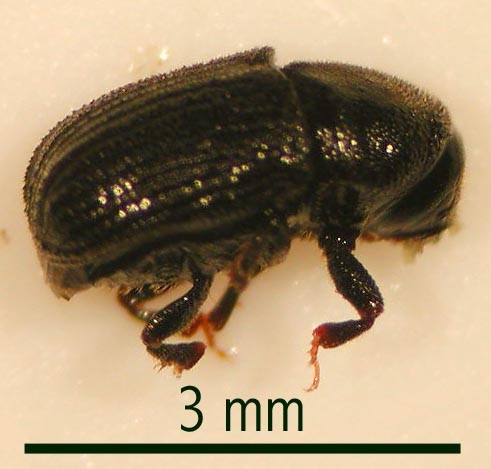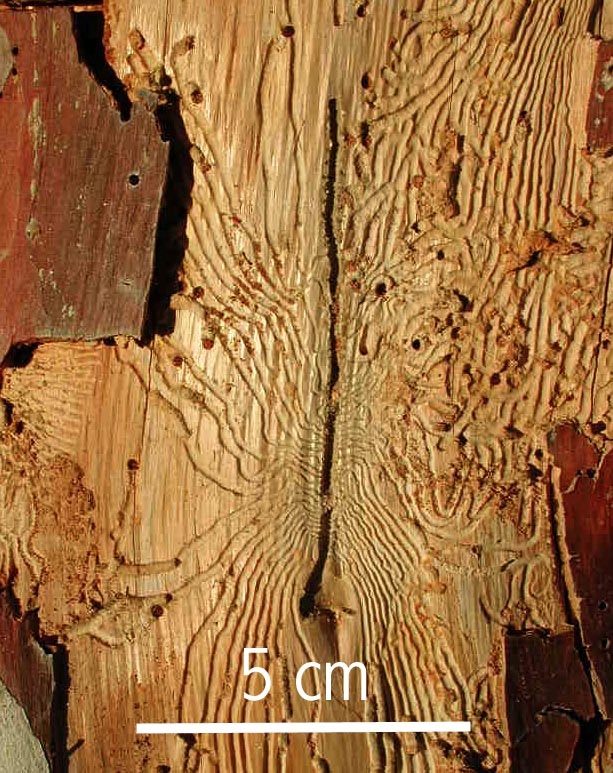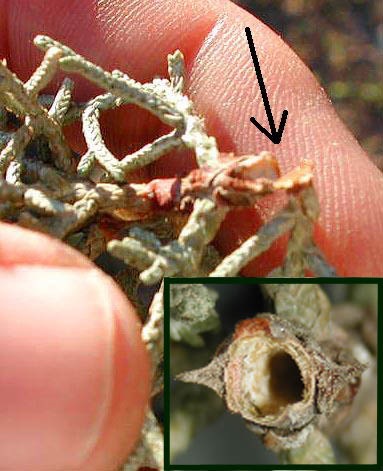 Cypress Bark Beetles - July 22, 2020 Jeff Schalau, Agent, Agriculture & Natural Resources University of Arizona Cooperative Extension, Yavapai County Cypress bark beetles (Phloeosinus spp.) are native insects that occur throughout Arizona. They are common in the Camp Verde, Cottonwood, Prescott, Sedona, Payson, and Kingman areas. In natural forests and woodlands, bark beetles act as natural thinning agents that remove dying, overcrowded, and unhealthy trees. Under drought conditions, populations of cypress bark beetles can increase allowing them to colonize and overcome seemingly healthy trees. In Arizona, the preferred host trees are Arizona cypress (Cupressus arizonica), Leyland cypress (Cupressocyparis leylandii), and native Junipers (Juniperus spp.). Cypress bark beetles often breed in the limbs and trunks of weakened, broken, dying, or felled trees and are common in juniper firewood. I have removed many juniper trees on my property and stacked it for firewood. When I’ve done this in late spring, summer, or early fall, cypress bark beetles colonized the stacked wood. Adult cypress bark beetles are small, reddish brown to black, often shiny, and about 2-3 mm long. The beetles colonize trees using two distinct methods. In weakened or stressed trees, adult beetles attack the bole (trunk) and larger branches of the tree where they mate and lay eggs. After the eggs hatch, the larvae (grubs) create new galleries which radiate outward from the central gallery. As they consume the inner bark, cambium, and outer sapwood, the tree is effectively girdled. Occasionally, beetle colonization causes top-kill or branch mortality, but often it leads to tree mortality. Trees are often colonized in the spring and summer and one generation per year is common. Newly emerged adults bore into small twigs a few inches from the branch tips. This kills the branch tip causing it to fade in color. The dead branch tip often remains hanging on the tree (called "flagging") for a short period before breaking off. You may also notice 6-8 inch branch tips on the ground below the tree’s canopy. Upon close inspection of the branch tips, a hollow area can be seen where the beetle mined the twig. When beetle populations are high, hundreds of branch tips may accumulate on the ground. This is not usually a problem if the colonized tree is being regularly irrigated. The loss of branch tips is a cosmetic issue and the tree will not suffer long-term damage. I have seen flagging and found adult beetles in these branch tips recently. Cultural practices can decrease the probability of beetle colonization. Dead and dying material should be pruned out of individual trees during winter. Maintaining tree health and vigor will also reduce the risk of beetle colonization. This is easily accomplished in residential landscapes by slow, deep, infrequent irrigation (twice per month) of susceptible trees species during drought periods (April-June and longer if needed). Irrigation can be applied using a soaker hose placed at the drip line of the tree. Do not fertilize cypress trees unless there are clear signs of nutrient deficiency (a very rare occurrence). Fertilized trees will have excessive growth, increased irrigation requirements, and be more attractive to browsing animals and damaging insects. Natural stands of Arizona cypress are often found in riparian areas or where soil moisture is more abundant than surrounding areas. Property owners often assume that because these trees are native they can survive without supplemental irrigation. This misconception causes many trees to die unnecessarily during Arizona's periodic droughts. Planted cypress trees should receive periodic irrigation during hot, droughty periods. Highly valued, cypress trees may be protected by spraying their bark with a persistent, specially-formulated insecticide meant specifically for bark beetle prevention. Common active ingredients in these insecticides are carbaryl and permethrin, but read the label to ensure the material is labeled as a preventive spray for bark beetles. Seriously infested trees, or trees that are dead or dying due to previous beetle attacks, cannot be saved with insecticide treatments and should be removed. Systemic insecticides, meaning those that are implanted or injected through the bark or applied to soil beneath trees, have not been shown to prevent attack or control populations of bark beetles. Although new systemic products are being investigated, they are not currently recommended for cypress bark beetle management. As mentioned above, Leyland cypress trees are also susceptible to bark beetles, but they should not be sold or planted because of their susceptibility to Seiridium Canker. This disease will kill any Leyland cypress planted in Yavapai County and beyond. Additional information is included below. You can follow the Backyard Gardener on Twitter – use the link on the BYG website. If you have other gardening questions, email the Master Gardener Help Desk in Prescott (prescottmg@gmail.com) or Camp Verde (verdevalleymg@gmail.com) and be sure to include your name, location, and phone number. Find past Backyard Gardener columns or provide feedback at the Backyard Gardener web site: https://cals.arizona.edu/yavapai/anr/hort/byg/. Images  Arizona cypress tree (Cupressus arizonica) growing in Sedona, Arizona (photo by Jeff Schalau, University of Arizona).
Arizona cypress tree (Cupressus arizonica) growing in Sedona, Arizona (photo by Jeff Schalau, University of Arizona). Cypress bark beetle, Phloeosinus spp. (photo by Jeff Schalau, University of Arizona).
Cypress bark beetle, Phloeosinus spp. (photo by Jeff Schalau, University of Arizona). Cypress bark beetle galleries taken after a tree has died and shed it's bark (photo by Jeff Schalau, University of Arizona).
Cypress bark beetle galleries taken after a tree has died and shed it's bark (photo by Jeff Schalau, University of Arizona). Cypress bark beetle damage that indicates they are active and present in the branch tips of the tree. These mined tunnels will often contain a single cypress bark beetle in the portion remaining on the tree. The dead branch tips are sometimes called "flags" (photo by Jeff Schalau, University of Arizona).
Cypress bark beetle damage that indicates they are active and present in the branch tips of the tree. These mined tunnels will often contain a single cypress bark beetle in the portion remaining on the tree. The dead branch tips are sometimes called "flags" (photo by Jeff Schalau, University of Arizona).Additional Resources Photos and Description of Arizona Cypress, University of Arizona Cooperative Extension cals.arizona.edu/yavapaiplants/SpeciesDetail.php?genus=Cupressus&species=arizonica Cypress Bark Beetles, University of Arizona Cooperative Extension extension.arizona.edu/sites/extension.arizona.edu/files/pubs/az1316.pdf How to Irrigate Efficiently, Utah State University Extension www.cwel.usu.edu/irrigation-extension Using Insecticides to Prevent Bark Beetle Attcks on Conifers, University of Arizona Cooperative Extension extension.arizona.edu/sites/extension.arizona.edu/files/pubs/az1380.pdf Seiridium Canker of Cypress Trees in Arizona, University of Arizona Cooperative Extension extension.arizona.edu/sites/extension.arizona.edu/files/pubs/az1557.pdf |